· Applications Now Open
SCI-Arc Breadcrumbs Home
SCI-Arc Breadcrumbs News
- September 28, 2021

SCI-Arc ‘Expands the Archive’ with 2021 Grad Thesis Weekend and Exhibition Film
SCI-Arc’s lively and immersive Graduate Thesis Weekend took place September 10-12, 2021, held both in person at SCI-Arc and remotely.
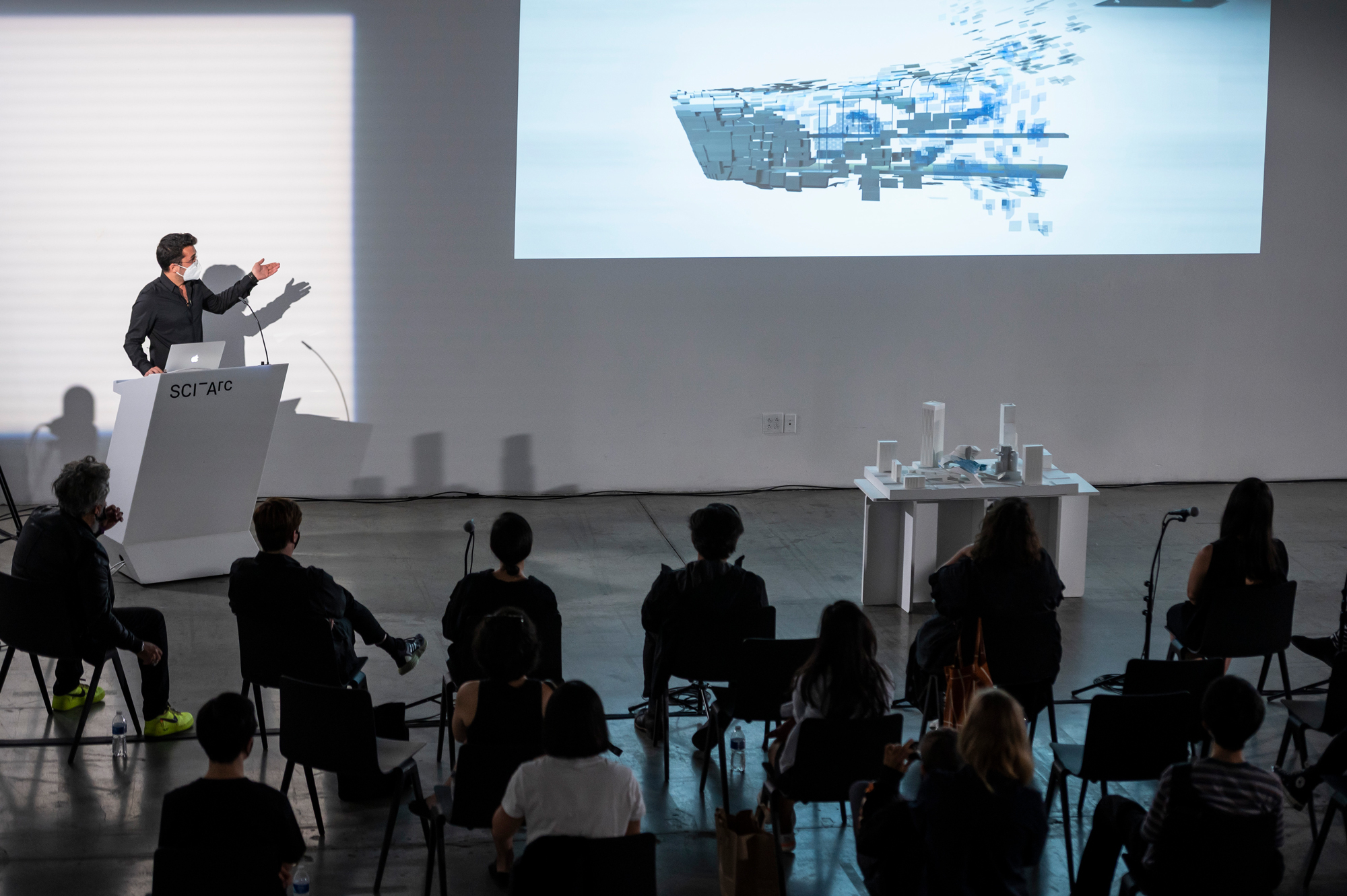
Featuring live-broadcast reviews streamed via the Graduate Thesis 2021 website , friends, family, and participants from all over the world were able to experience the extraordinary work of SCI-Arc’s graduating class. For Graduate Thesis 2021, graduating thesis students presented their completed projects on a public platform to over 100 jurors, critics, and architecture professionals from around the globe who discussed, debated, and disputed emerging questions in architecture.
Graduate Thesis is the culminating project of SCI-Arc’s curriculum that prepares M.Arch 1 and M.Arch 2 graduate students to make a statement and form a commitment that establishes their orientation to future architectural work. This year’s thesis has collectively explored the theme of “expanding the archive,” with every thesis project tackling questions and problems urgent to the discipline of architecture in 2021, “making an attempt not only to synthesize the practice of design as it is now, but as it might become,” explains this year’s official thesis description by 2021 Graduate Thesis co-coordinators John Cooper and Kristy Balliet. “This means taking account of the situatedness of every thesis project in relation to its many entanglements with the history and theory of the discipline, society, and environment, and projecting them forward into new possible futures.”
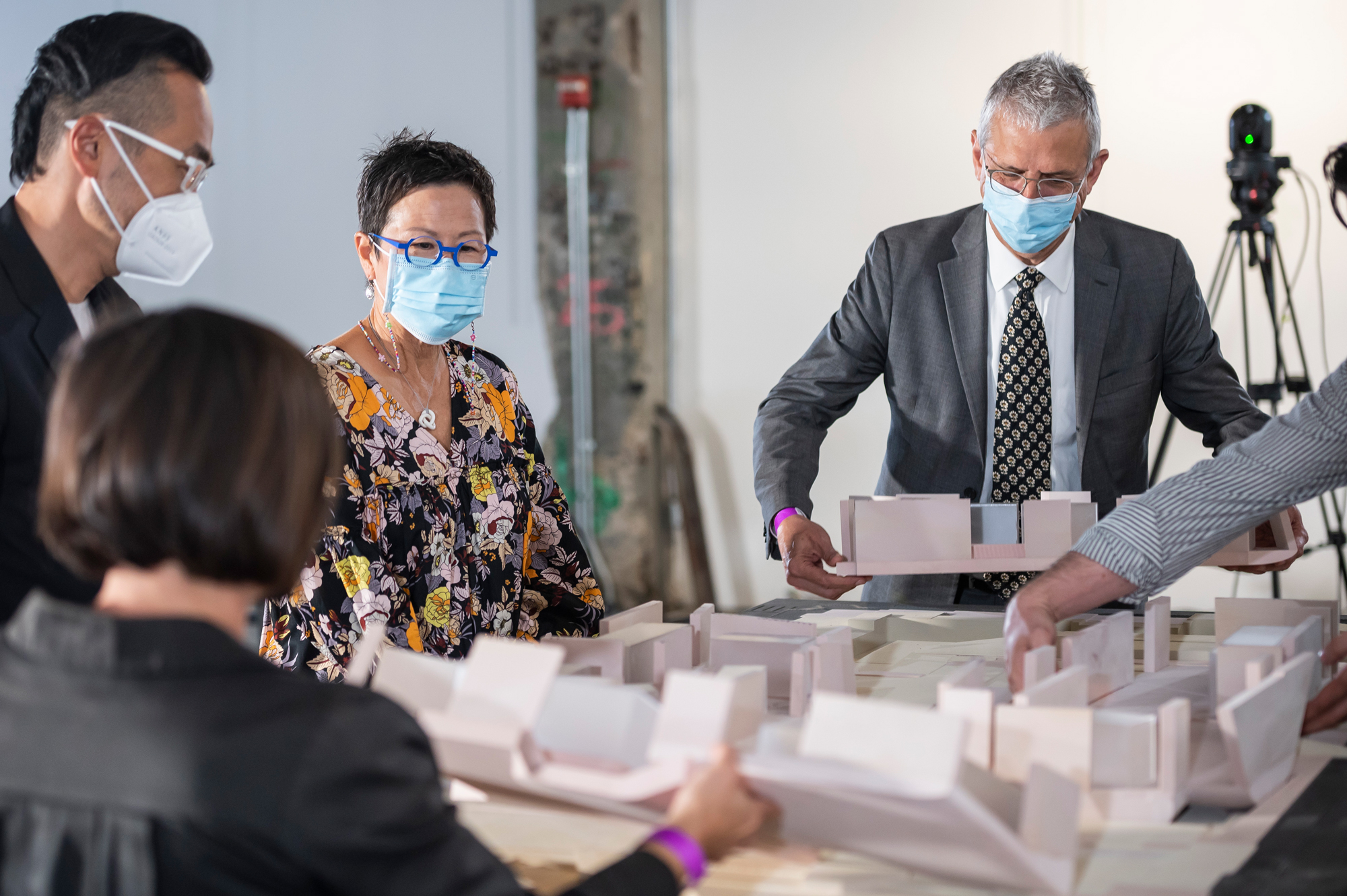
The theme of “expanding the archive” has connected student work, invited lectures, and collective conversation across the year. The annual summer thesis FORM@ lectures and Spin Room sessions were streamed live on the Graduate Thesis 2021 website and brought in powerful voices that challenge the architecture community to rethink who and what is included in architectural archives. AI and software-based environments, race and surveillance, crip technoscience, exhibiting histories of urbanism, the poetics of sanctuary in the architecture of Paul Williams, and architecture’s relationship to nature were all subjects critically engaged in the forum of thesis through these lectures which have provided a backdrop against which students have projected their work into new architectural futures. Earlier this summer, the “Planet Thesis” public symposium, hosted by a virtual avatar, explored the new territories opened up by student projects.

Several examples of outstanding student work represented throughout the weekend came from some of this year’s Merit Graduate Thesis Award Winners. Envirovore by Alexandros Lewis (M.Arch 2 ‘21) reimagines marine infrastructure in the face of climate change. His project enacts a bio-reacting structure on a site located in the town of Portree at the isle of Skye, Scotland that uses tectonics as a vehicle, featuring manipulated skin as a host for marine life, reef, and maerl beds; ecosystems that are threatened by pollution from domestic sewage, oil spills in the sea, sedimentation, and by the rising of ocean temperatures.
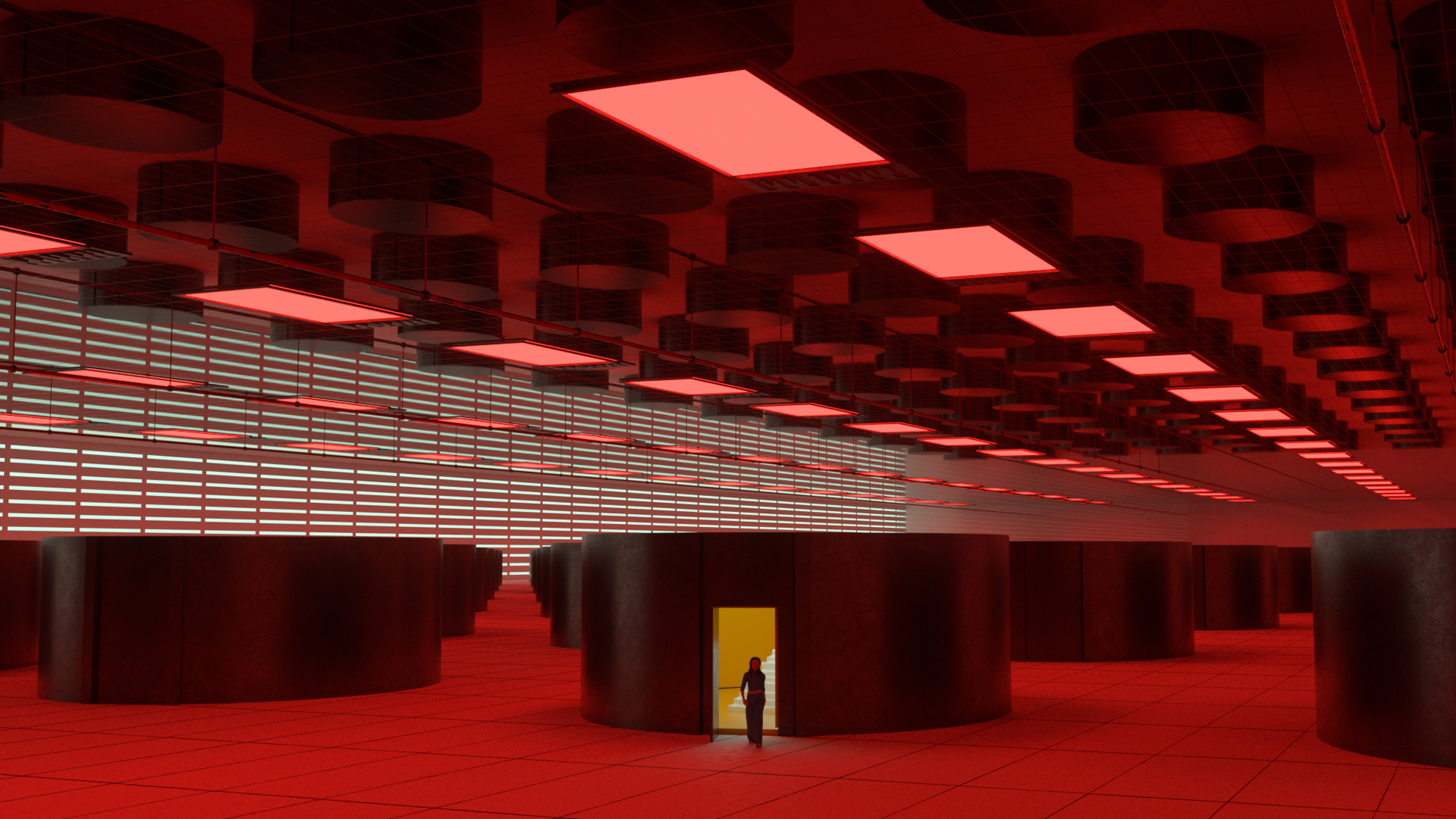
In her thesis, Pledge of Allegiance , Julia Mae McConnell (M.Arch 1 ‘21) references political theater, creating a speculative fiction animated short film centered around the Oval Office, presenting the storied room within complex shifting perspectives mediated by the collective memory of the nation.
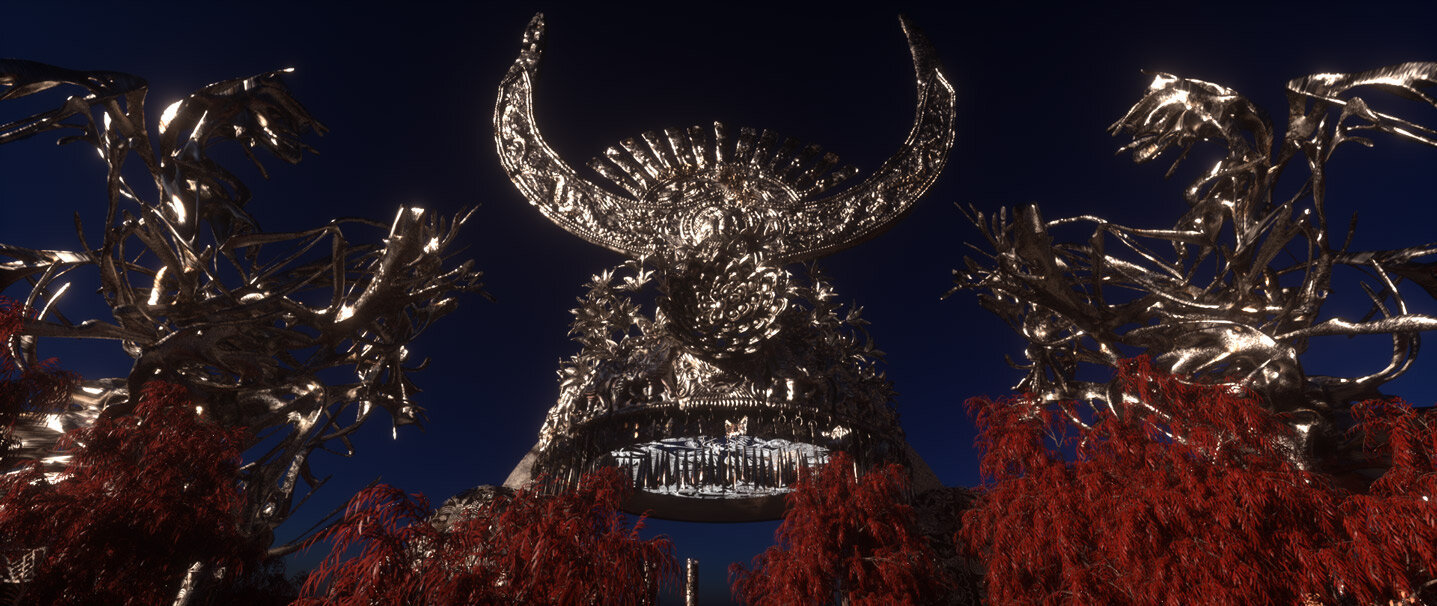
Yutao Fang (M.Arch 2 ‘21) in his thesis 未决录 Experience, Experiment, Expectation constructs a non-linear, Asian-futurist narrative to interpret the tradition and mystics of the Miao people which ascribe life and meaning to inanimate objects, merging into nature and technology.
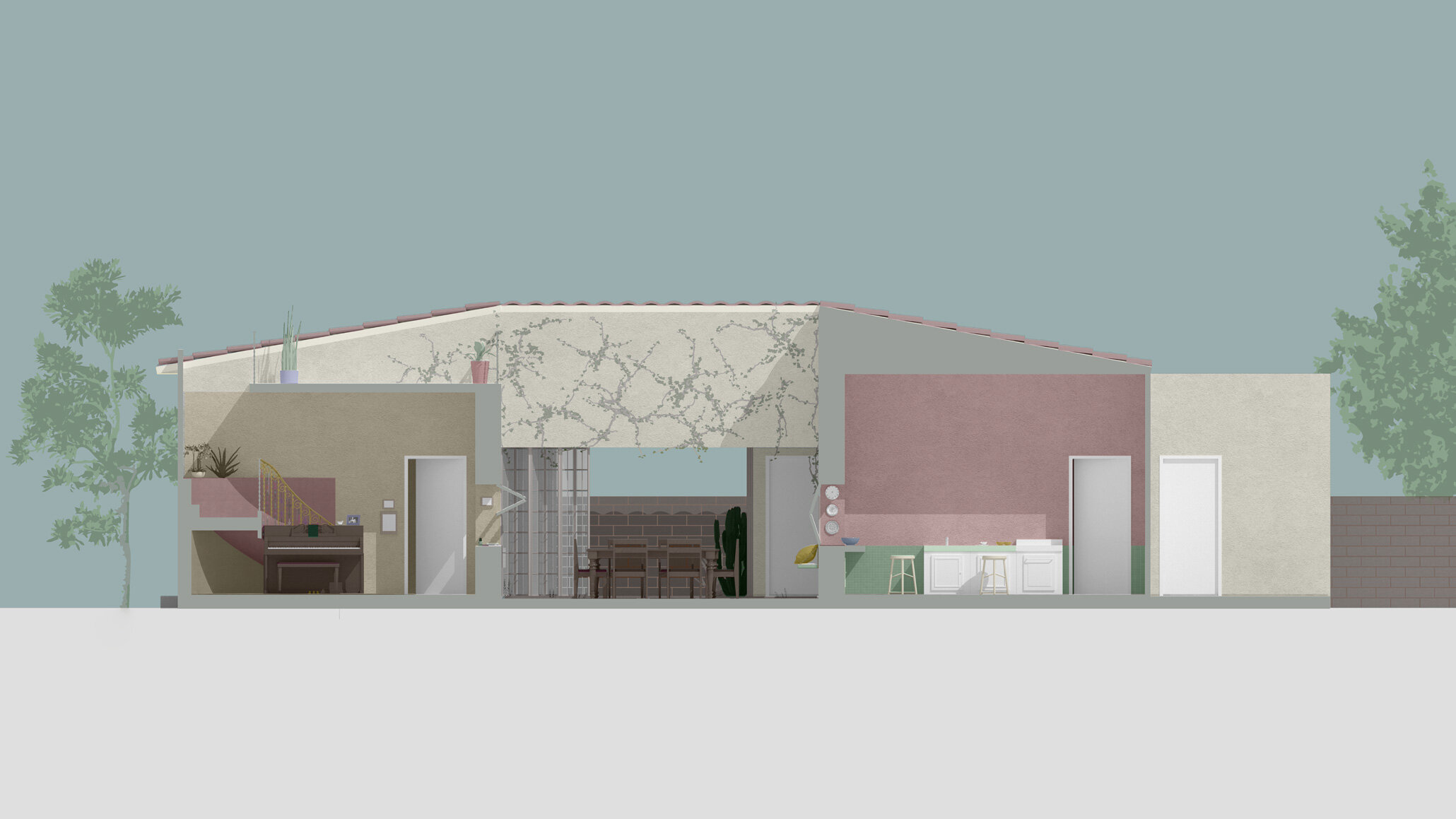
In a personal and research-based meditation on post-war suburbia entitled Atypical , Lauren Carmen Hanna (M.Arch 1 ‘21) reimagines the home as occupied by a multigenerational family, subverting the historical narrative of suburban middle-class whiteness and the American Dream.
Emerging out of a time of crisis and transformation, the architectural projects featured in this year’s thesis expand not only what is included within architecture, but also how to do the work of architecture in the present, how to speculate, how to engage in current issues, and how to communicate architecture’s purpose to the wider world. An accompanying film comprised of selected works from this year’s thesis class, also entitled Expanding the Archive , will be screened live both in person and online on October 1, with an accompanying exhibition of the film on campus at SCI-Arc. Expanding the Archive will capture the planetary scope of architectural thinking at SCI-Arc, showcasing projects which were conceived, developed, and shared across time zones, cities, and social contexts, linked by the collective act of imagining alternative futures while also engaging architecture’s past.
“Many of this year’s thesis projects reach out and engage new publics and audiences in a range of architectural languages, claiming technological experimentation and formal adventurousness as scenes of direct cultural engagement across multiple scales: from spectacular urbanism and symbiotic landscapes, to microcosmic interiors and many gradations in between,” added Balliet and Cooper. “Together, these projects testify to the power of imagination to generate optimism out of crisis and reset the standards of what architecture can be.”
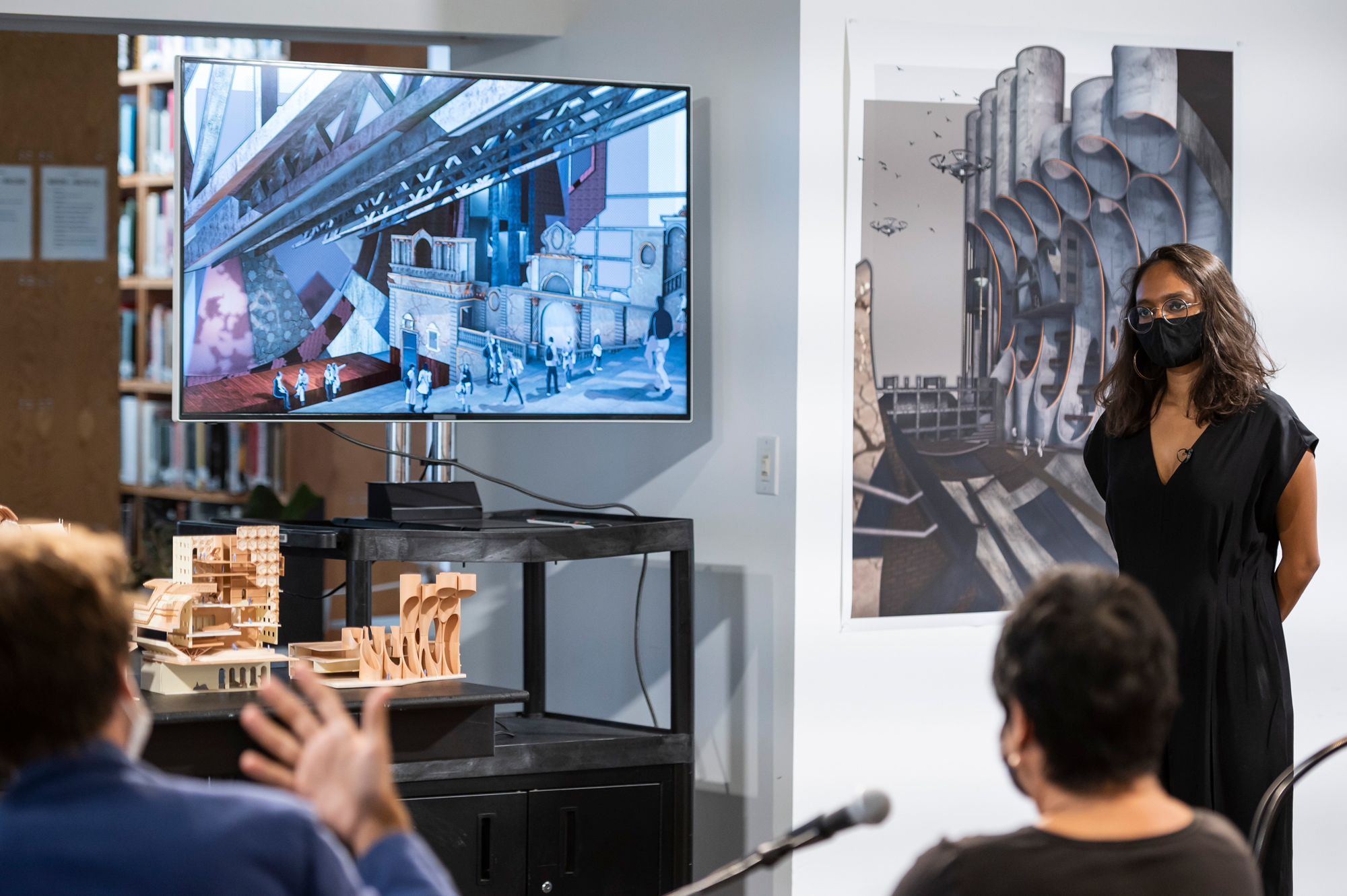
“Architects owe it to those who today are making a sacrifice to secure the greater good to build a post-pandemic world that is better and more just than the one that preceded it—and this is exactly what our 2021 graduate students did,” said SCI-Arc Graduate Programs Chair Elena Manderdini. “This summer was permeated by a sense of solidarity and shared responsibility, in support of a more inclusive architecture. Our SCI-Arc Graduate Thesis class questioned and challenged every given architectural canon and gifted us with their inventions to visualize the change we all want to see.”
Complete list of Graduate Thesis award winners is below. Archived reviews, lectures, Spin Room sessions, and student projects can be viewed on the Graduate Thesis 2021 website .
Expanding the Archive: A 2021 Graduate Thesis Film will be screened online with a reception taking place in W.M. Keck Lecture Hall on October 1 at 6:00pm PT. Screening can be viewed live on SCI-Arc’s livestream channel .
Merit Graduate Thesis Award Winners
- Yixuan Cai (M.Arch 2)
- Yutao Fang (M.Arch 2)
- Sohail Gil (M.Arch 1)
- Nicholas Kenny Gochnour (M.Arch 1)
- Lauren Carmen Hanna (M.Arch 1)
- Jessie Vivian Helgesen (M.Arch 1)
- René Pérez Ignacio (M.Arch 2)
- Carnation Kng Ni Xin (M.Arch 2)
- Alexandros Lewis (M.Arch 2)
- Di Liang (M.Arch 2)
- Julia Mae McConnell (M.Arch 1)
- Hans Karl Steffes (M.Arch 2)
SCI-Arc Gehry Prize Winners
- Burak Celik (M.Arch 2)
- Julie Elizabeth Riley (M.Arch 1)
Wood self-construction workshop_Camposaz 39:39 Vicenza
Vicenza (VI), Veneto, Italy

SCI-Arc Graduate and 2021 Gehry Prize Winner Proposes New Perspectives Between City Structures and Augmented Reality Holograms
Continuing with Archinect's commitment to highlighting students and their academic work, we connected with SCI-Arc M.Arch II graduate Burak Celik . As the 2021 Gehry Prize Winner for best thesis, Celik talks to us about his project "Super•positioning." He uses Los Angeles as a backdrop for exploring architecture and its relationship between digital and analog, reality and speculation, and how the use of superpositioning allowed him to question other architectural perspectives. The word superposition is defined as "the placement of one thing above or on top of another" and "the combination of two distinct physical phenomena of the same type (such as spin or wavelength) so that they coexist as part of the same event." Celik uses this as the basis for thesis exploration.
"Today's digital culture would be embraced by architects not only as a means of software and tools but also as a complete architectural experience by the viewer," Celik explains and continues by sharing: "Through superpositioning, certain limitations like time, constructibility, and technology would be turned into an advantage in design and become the next turning point in architecture." Together, we also discuss his experiences as an M.Arch student at SCI-Arc, challenges he faced during the pandemic, and his thoughts on the industry post-graduation.
Archinect's Spotlight on 2021 Thesis Projects: Archinect's commitment to highlighting student work doesn't stop at simply sharing projects. Our editorial team focuses on connecting with students and asking questions to learn their process, architectural perspectives, and their take on the industry as young designers. 2020/21 has been a challenging year for all architecture graduates; to support the class of 2021, we've launched our summer series iteration of Archinect's Thesis Review to highlight the work of thesis students during this unique time of remote learning amid the COVID-19 pandemic. Be sure to follow our 2021 thesis tag to stay up to date as we release new project highlights.
My thesis understands superpositioning through the interplay between digital and analog, between cyberspace and real space, between augmented and virtual reality to uncover the latent structures within current post-digital aesthetics.

Please provide a brief summary of your thesis project.
My thesis understands superpositioning through the interplay between digital and analog, between cyberspace and real space, between augmented and virtual reality to uncover the latent structures within current post-digital aesthetics. Superpositioning is central to architecture. It brings into existence that there are new types of architectural edges and it questions how these new hybridities would present new potential sites of convergence in architectural discourse.
Hologram has been increasingly popular in its attempts to link both digital and physical worlds. The technique involves Hologram/AR to visualize the data because it is a highly effective and available tool with today’s technology and a great tool with interactive features. With holograms, one can see, sense, and connect with art, events, and entertainment in greater depth than ever before.
Today’s digital culture would be embraced by architects not only as a means of software and tools but also as a complete architectural experience by the viewer. Through superpositioning, certain limitations like time, constructibility, and technology would be turned into an advantage in design and become the next turning point in architecture.

Superpositioning is central to architecture. It brings into existence that there are new types of architectural edges and it questions how these new hybridities would present new potential sites of convergence in architectural discourse.

How does your thesis fit within OR challenge the discipline of architecture?
Michel Foucault, as a sociologist, addresses the relationship between power, order, and knowledge, and how they are used as a form of social control through societal institutions. Bernard Tschumi sees these layers as meaning-making devices and how one is not necessarily linked to each other in rigid ways. Tschumi’s critique of institutions is visible in his work in Parc de la Villette with superpositioning of events in 1987. In quantum mechanics, a superposition is an object which is in many different states, and yet when you look, you can only observe one of those states.
Superpositioning is about the memory/influence of a building; it does not require an existing building itself. It is a spatial way of defining togetherness. It’s almost like reading layers of information and perceiving them all together. Just like a building, the city itself has multiple layers in it, many superpositionings happening through time. Driving through the city in the 1960s and 2020s have two different feelings. The reason why the city is meeting this topic right now is that the way we experience/move through the city is changing. My thesis challenges those aspects of life and the role of architecture. It aligns itself with the notion of superpositioning. It challenges those ideas with today's digital culture through the methodology of urban infill and holograms, which is an image in flux and constantly in change similar to today's big data environment. Diving deep into the relationship between big data and architecture and looking at superpositioning in time opened up new discussions, especially during my final review where I received rich feedback from my jury.
Superpositioning is about the memory/influence of a building; it does not require an existing building itself. It is a spatial way of defining togetherness.
Did your thesis change during the pandemic? What difficulties did you face? How did your thesis advisors help you during this time?
There was a time I had to visit my home country (Turkey) and come back. Being on the other side of the world, and under a national lockdown for three weeks, my thesis advisor, Kristy Balliet , and I worked against an eleven-hour time difference and made it through. After those difficult times, I’ve had the chance and opportunity to work with her in person at SCI-Arc by following all the safety protocols. I feel so lucky to have Kristy Balliet supporting me in every challenge. Also, I feel so lucky to have my Cultural Agent, Jasmine Benyamin, being a great mind behind the theory of my Gehry Prize-awarded thesis.
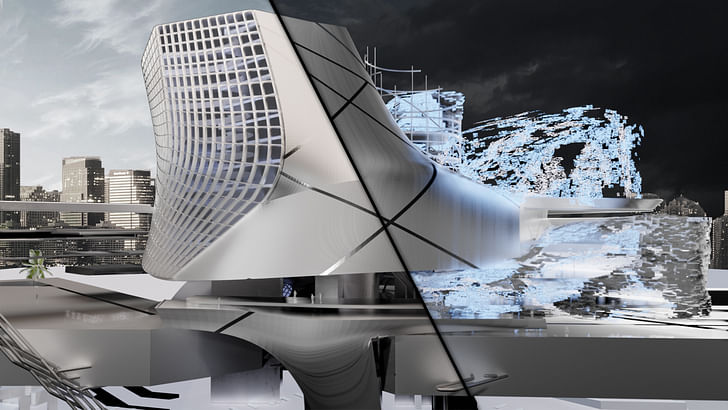
What are your next steps academically? Professionally?
Architecture is an ever-growing field where the bond between rapid architectural developments and academic research is strong. I am planning to stay in the professional environment for a while, working for the firm I am currently with. Yet, I would also like to contribute to and be involved in academia through research collaborations and teaching. I am glad to be receiving invitations for being a jury for design studios and other courses now from the US and Turkey. These opportunities make me excited about the academic environment. I believe that pursuing my career in both tracks through research, development, and application will provide me with a broad vision, opening the way for a thorough professional career in architectural technologies.
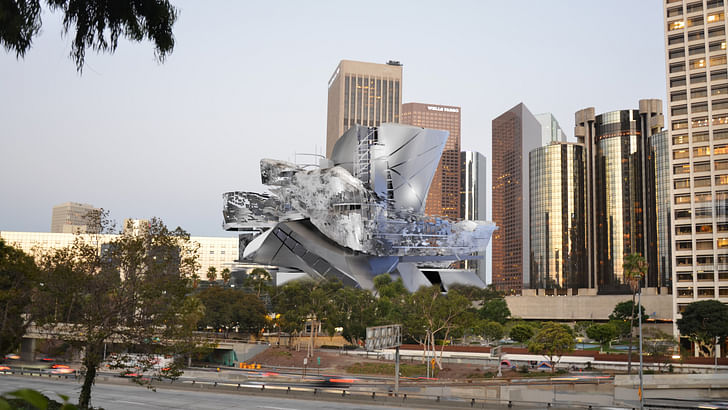
As a recent graduate experiencing the direct effects of the pandemic, how do you feel about the architecture industry right now?
I always (try to) look at things in a positive way, which I believe is the duty of architects looking for ways to resolve issues.
There is a quote from our Director Hernan Diaz Alonso, stating “Architecture is always an act of optimism,” and I truly believe in that. The pandemic has taught us many things, from improving our way of living, working from home, and working remotely from the other side of the world. After the pandemic, people started looking for new projects and investments. As the industry reopens, there are great opportunities out there. However, we should always look for ways to lower our carbon footprint and save the environment while doing so. On a global level, every project and every decision we are making matters. It’s not only the pandemic but wildfires, climate change, and the climate crisis. These are real and become more serious if we don’t change the way we live.
[Super•positioning] Video courtesy of Burak Celik
What has helped prepare you for the workforce?
Graduating from SCI-Arc has helped me build a strong work ethic that has to do with deadlines and time management. In addition to this, having the desire to learn new things daily, work in teams, leading them, and producing high-quality work. I feel lucky to have such strong connections with practicing instructors which allowed me to learn things from active professionals. This enabled me to develop strong work habits all while delivering them to a group of practitioners who have high expectations. While I have had professional experience with international firms like Studio Libeskind , Oyler Wu Collaborative , and Melike Altinisik Architects , the network of architects and inspiring students at SCI-Arc made me strive for more all the time. I believe in learning something from someone by watching, observing, and collaborating. The studio environment at SCI-Arc has shaped my architectural vision, and I am so thankful to those who were around me.
Similar articles on Archinect that may interest you...
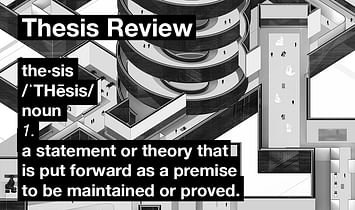
Related Archinect Profiles

No Comments
Block this user.
Are you sure you want to block this user and hide all related comments throughout the site?
This is your first comment on Archinect. Your comment will be visible once approved.
- Back to Features List...
- » Architectural Issues
- » Culture
- » Architects
- » Design
- » Academia
- ↓ More
- » Buildings
- » Business
- » Employment
- » Technology
- » Film/Video/Photography
- » Urban Planning
- » Sustainability
- » Events
- » Landscape
- » Web
- » Competition
- » Furniture
- » View All
- × Search in:
- All of Archinect
Graduate Thesis Lecture Series
Graduate thesis at SCI-Arc is an opportunity for M.Arch students to explore a set of relevant disciplinary issues as they complete their programs of study and research with a presentation and public exhibition of an individual disciplinary position that expands the boundaries of contemporary architectural practice.
The Form@ series of discussions focus on on topics relevant to graduate students working on their thesis projects.

Alumni + Graduate Thesis mixer (July 19, 2023)
Winners of the best graduate thesis prize of 2022 talk to the class of 2023.

Ecological aesthetics (July 26, 2023)
The third 2023 Graduate Thesis symposium focuses on critically engaging nature and design.

Building a blank (June 28, 2023)
Principals from four studios discuss their architecture in terms of building.

Techniques of imagination (May 31, 2023)
A panel discussion on AI.

Alexander Galloway: Form@ lecture (July 1, 2022)
Alexander Galloway discusses the diagonal line as a technology.

Bryony Roberts: Form@ lecture (June 1, 2022)
Bryony Roberts discusses her research and design practice, focusing on spatial conditions of the public realm, and the social and cultural conditions that inform them.

Aimi Hamraie & Kelly Fritsch : Form@ lecture / Crip techno-science (August 2, 2021)
Aimi Hamraie and Kelly Fritsch arguefor a crip technoscience as acritical project that centers the experiences of disabled people as designers.

Justine Poulin, Richard Mapes, Liang Yu, Irvin Shaifa : Form@ lecture / Gehry league (July 26, 2021)
Past winners of the Gehry Prize for best graduate thesis project share their experiences of thesis with the current class.

Barry Wark : Form@ lecture / Ancientness & future forms of coexistence (July 12, 2021)
Barry Wark discusses the possibilities of an eco-centric architecture.

John Carpenter : Form@ lecture / New ways of seeing the pattern (July 7, 2021)
Carpenter discusses the critical need for new tools and techniques to visualize, filter, interpret, and share high-dimensional datasets.

LeRonn P. Brooks : Form@ lecture / Poetics of sanctuary & place : Paul R. Williams (June 28, 2021)
LeRonn P. Brooks discusses the work of Paul R. Williams in the context of Los Angeles.

Mimi Zeiger : Form@ lecture / New middles (June 21, 2021)
Mimi Zeiger discusses the modernist legacy of Columbus, Ohio.

Matt Checkowski : Form@ lecture / Making moments on a changing landscape (June 7, 2021)
Matt Checkowski discusses his work at the intersection of storytelling, design, and technology.

Kristy Balliet & John Cooper : Form@ lecture / Planet thesis (May 26, 2021)
Kristy Balliet and John Cooper moderate a discussion on graduate thesis at SCI-Arc.

Karel Klein & David Ruy : Form@ lecture / Automatic aesthetic (August 3, 2020)
Klein and Ruy discuss AI in the field of architecture.


Daniel Birnbaum : Form@ lecture / Continuous simulations (July 20, 2020)
Daniel Birnbaum discusses challenges facing the production and display of art today.

Mario Carpo : Form@ lecture / Coronavirus, or the revival of the Internet (July 13, 2020)
How the coronavirus crisis has transformed our relationship to technology.

Andrew Kovacs : Form@ lecture / Collage unplugged (June 22, 2020)
Freestyle model making and 3-dimensional assemblage.

Lev Manovich : Form@ lecture / The aesthetic society (June 15, 2020)
Lev Manovich analyzes the visual aesthetics of Instagram.

Jasmine Benyamin : Form@ lecture / Space trafficking (June 8, 2020)
A discussion of current museological conditions of display and dissemination.

Graduate thesis faculty & students live chat (June 5, 2020)
Graduate thesis students and faculty meet as a group via Zoom and discuss logistics, schedules, and goals.

Florencia Pita : Form@ lecture / Miniatures (June 1, 2020)
A lecture about portable art, music boxes, dollhouses and tiny models.

Kristy Balliet & Casey Rehm: Form@: Sketch (June 16, 2017)

Elena Manferdini & Florencia Pita: Form@ Color (June 2, 2017)

David Ruy & Peter Trummer: Form@: Collage (May 31, 2017)

Elena Manferdini: Form@ Genius vs Masters (May 19, 2017)
More collections, in memory of henry “harry” n. cobb, making+meaning: redefining design through alphabetical explorations, archive highlights: pioneering designers in space, a queer query.
- Collections
- Media Archive
SCI-Arc Media Archive
The SCI-Arc Media Archive is a continuously-expanding online showcase with over 1000 hours of video, featuring the world’s most significant architects, designers, and theorists—including 11 Pritzker Prize winners—from 1972 to now, offered to the public unedited, for students, scholars and anybody with an interest in architecture, Los Angeles and experimental design.
From the beginning, SCI-Arc has actively engaged the community with public programs, including a lecture series, which started in 1974 and still happens Wednesday nights. Most of these videos document public events held at SCI-Arc. Support for the Media Archive was provided by The Getty Foundation and the National Endowment for the Arts.

Victor Mukhin
- Scientific Program

Title : Active carbons as nanoporous materials for solving of environmental problems
However, up to now, the main carriers of catalytic additives have been mineral sorbents: silica gels, alumogels. This is obviously due to the fact that they consist of pure homogeneous components SiO2 and Al2O3, respectively. It is generally known that impurities, especially the ash elements, are catalytic poisons that reduce the effectiveness of the catalyst. Therefore, carbon sorbents with 5-15% by weight of ash elements in their composition are not used in the above mentioned technologies. However, in such an important field as a gas-mask technique, carbon sorbents (active carbons) are carriers of catalytic additives, providing effective protection of a person against any types of potent poisonous substances (PPS). In ESPE “JSC "Neorganika" there has been developed the technology of unique ashless spherical carbon carrier-catalysts by the method of liquid forming of furfural copolymers with subsequent gas-vapor activation, brand PAC. Active carbons PAC have 100% qualitative characteristics of the three main properties of carbon sorbents: strength - 100%, the proportion of sorbing pores in the pore space – 100%, purity - 100% (ash content is close to zero). A particularly outstanding feature of active PAC carbons is their uniquely high mechanical compressive strength of 740 ± 40 MPa, which is 3-7 times larger than that of such materials as granite, quartzite, electric coal, and is comparable to the value for cast iron - 400-1000 MPa. This allows the PAC to operate under severe conditions in moving and fluidized beds. Obviously, it is time to actively develop catalysts based on PAC sorbents for oil refining, petrochemicals, gas processing and various technologies of organic synthesis.
Victor M. Mukhin was born in 1946 in the town of Orsk, Russia. In 1970 he graduated the Technological Institute in Leningrad. Victor M. Mukhin was directed to work to the scientific-industrial organization "Neorganika" (Elektrostal, Moscow region) where he is working during 47 years, at present as the head of the laboratory of carbon sorbents. Victor M. Mukhin defended a Ph. D. thesis and a doctoral thesis at the Mendeleev University of Chemical Technology of Russia (in 1979 and 1997 accordingly). Professor of Mendeleev University of Chemical Technology of Russia. Scientific interests: production, investigation and application of active carbons, technological and ecological carbon-adsorptive processes, environmental protection, production of ecologically clean food.
Quick Links
- Conference Brochure
- Tentative Program


- People Directory
- Safety at UD

Category: Animal and Food Sciences
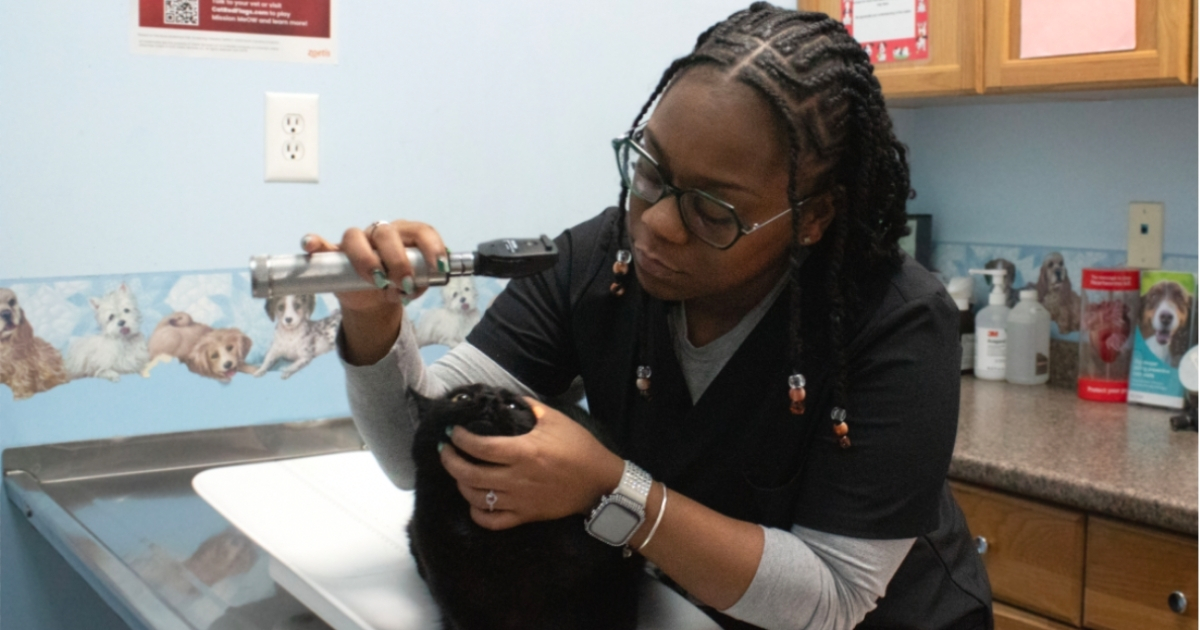
UD’s non-thesis M.S. in Animal Science prepares Kayla Pettiford for veterinary school
May 02, 2024 Written by Molly Schafer | Photos by Jeremy Wayman
Growing up with guinea pigs, hamsters, parakeets, turtles, and fish, University of Delaware alumna Kayla Pettiford planned a career in veterinary medicine from a young age.
"It's always been what I wanted to do,” said Pettiford, an alumna of UD’s non-thesis master’s in Animal Science . “And I can't see myself doing anything else."
Veterinary school acceptance is notoriously competitive, and the rigorous training can make for a stressful experience.
“I know many students feel overwhelmed and stressed in veterinary school, and I didn't want to feel that way,” said Pettiford. “Everybody's journey to vet school can look a little different. I knew I needed more technical understanding and background.”
Pettiford graduated with an undergraduate degree in pre-veterinary science from Delaware State University in 2021. Pettiford took her time researching master’s programs. UD's concentration in Veterinary Biosciences, Biotechnology, and One Health (VBBOH) stood out.
“I wanted to put myself at a university where I would gain the most experience,” explained Pettiford.
At UD, Pettiford worked closely with Behnam Abasht , professor of animal genetics, on his research into wooden breast, a muscle disorder in commercial broiler chickens.
“We hatched the eggs, cared for the chicks, performed necropsies, looked through the microscope,” Pettiford remarked. “Seeing the research from beginning to end was eye-opening. And Prof. Abasht walked me through the process.”
Pettiford found the study of histopathology, the microscopic examination of tissue and cells to diagnose disease, exciting.
“Histopathology wasn't even on my radar before the non-thesis master’s program,” she emphasized. “Now, it will become my focus; my lab and research experience at UD gave me that direction.”
After finishing her UD graduate program, Pettiford is ready for veterinary school. She is thankful to Prof. Tanya Gressley, associate dean of graduate programs, who answered Pettiford's many questions from the application process through graduation.
“She helped prepare me,” acknowledged Pettiford. “I feel confident that when I go to vet school, I will have a solid background to help me. That is the most important thing: having a solid foundation.”
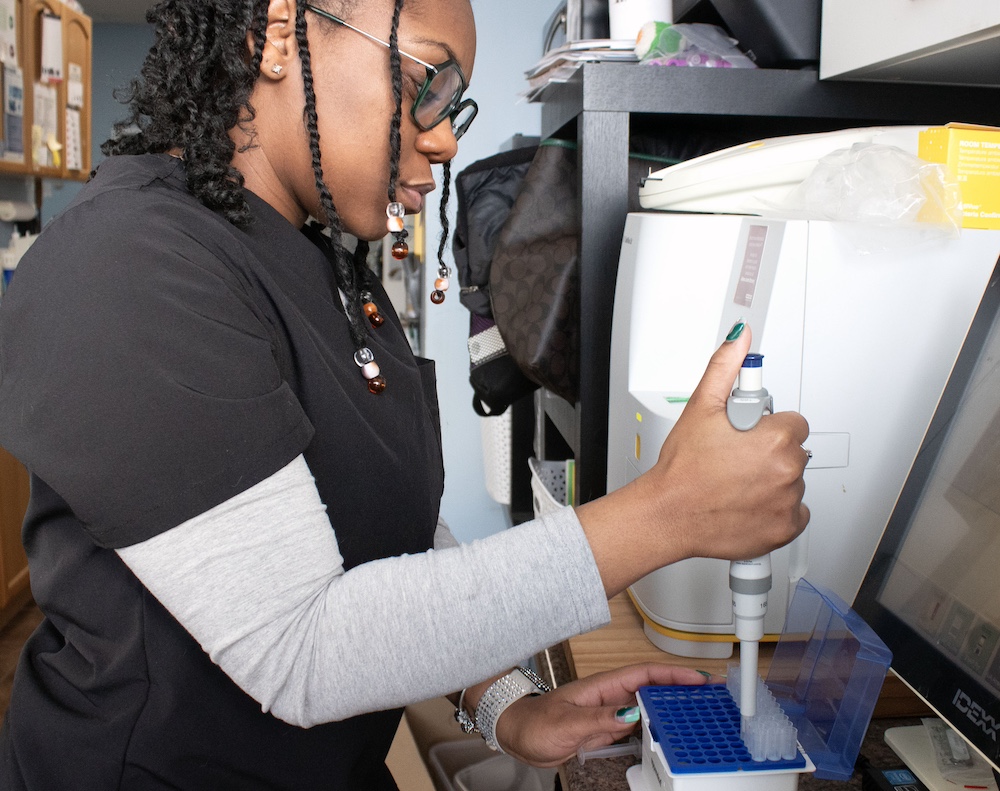
Pettiford believes good communication skills are essential to succeed as a veterinarian. Her role as a teaching assistant for Prof. Gressley’s Animal Handling (ANFS 112 ) course helped her grow these skills. Communication is vital in her current role as a veterinary technician at Animal Haven Veterinary Center in Bear, Delaware.
“I just love meeting new pet parents,” said Pettiford. “It's always a good experience to teach them new things and answer questions that they might have.”
Working with small animals and cancer patients as a veterinary technician broadened her animal handling experience.
“I love what I do as a technician: making sure the pet is comfortable, doing the best I can for their care,” attested Pettiford “That's something I take pride in doing.”
Pettiford prepares her veterinary school applications with an eye to the future. She plans to focus on exotic animals and wildlife along with histopathology.
“I want every day I show up to work to be unique and spontaneous!”
Related News
Meet our new faculty: alexander yitbarek, get ready for ag day.
- Cooperative Extension
- Plant and Soil Sciences
- Entomology and Wildlife Ecology
- Animal and Food Sciences
- Undergraduate Students
- Applied Economics and Statistics
- Graduate Students
- CANR Facilities
- Agriculture and Natural Resources
- Graduate Programs
- Nutrition, Food Safety and Wellness
- UDairy Creamery
- Equine Science
- Undergraduate Majors
- 4-H Youth Development
- Master Gardeners
- Pest Management
- Sustainable Production Systems
- Doug Tallamy
- Lawn and Garden
- Environmental Stewardship
- Center for Experimental and Applied Economics
- Health and Wellbeing
- Internships
- Rodrigo Vargas
- Nutrient Management
- Master Naturalist Program
- Master Wellness
- Chris Williams
- Carvel-Research
- Health Insurance
- UD Waterfowl
- UD Fresh to You
- Forest Fragments in Managed Ecosystems
- Rice Paddies
- Master Gardener Book Reviews
- MS Soil Science
- Greenhouse Gases
- Dining with Diabetes
- Delaware FitBiz
- Well Connected Community
- Spanish Language
- Financial Management
- Charles C. Allen Biotechnology Laboratory
- LEADelaware
- Wellness Dimensions
College of Agriculture & Natural Resources
Additional Links
- Faculty & Staff Resources
531 South College Avenue Newark, DE 19716 (302) 831-2501
Developing ash-free high-strength spherical carbon catalyst supports
- Domestic Catalysts
- Published: 28 June 2013
- Volume 5 , pages 156–163, ( 2013 )
Cite this article

- V. V. Gur’yanov 1 ,
- V. M. Mukhin 1 &
- A. A. Kurilkin 1
49 Accesses
Explore all metrics
The possibility of using furfurol for the production of ash-free high-strength active carbons with spheroidal particles as adsorbents and catalyst supports is substantiated. A single-stage process that incorporates the resinification of furfurol, the molding of a spherical product, and its hardening while allowing the process cycle time and the cost of equipment to be reduced is developed. Derivatographic, X-ray diffraction, mercury porometric, and adsorption studies of the carbonization of the molded spherical product are performed to characterize the development of the primary and porous structures of carbon residues. Ash-free active carbons with spheroidal particles, a full volume of sorbing micro- and mesopores (up to 1.50 cm 3 /g), and a uniquely high mechanical strength (its abrasion rate is three orders of magnitude lower than that of industrial active carbons) are obtained via the vapor-gas activation of a carbonized product. The obtained active carbons are superior to all known foreign and domestic analogues and are promising for the production of catalysts that operate under severe regimes, i.e., in moving and fluidized beds.
This is a preview of subscription content, log in via an institution to check access.
Access this article
Price includes VAT (Russian Federation)
Instant access to the full article PDF.
Rent this article via DeepDyve
Institutional subscriptions
Similar content being viewed by others
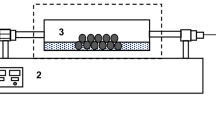
Optimization of the preparation conditions for cocoa shell-based activated carbon and its evaluation as salts adsorbent material

Carbon adsorbents for methane storage: genesis, synthesis, porosity, adsorption
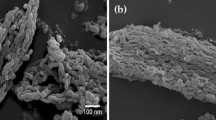
Hierarchical nanostructured carbons as CO2 adsorbents
Burushkina, T.N., Zh. Ross. Khim. O-va im. D.I. Mendeleeva , 1995, vol. 39, no. 6, p. 122.
CAS Google Scholar
Kryazhev, Yu. G., Abstract of Papers, Materialy XII vserossiiskogo simpoziuma s uchastiem inostrannykh uchenykh “Aktual’nye problemy teorii adsorptsii, poristosti i adsorptsionnoi selektivnosti” (Proc. of XII th All-Russia Symposium with the Participation of Foreign Scientists “Urgent Problems of the Theory of Adsorption, Porosity, and Adsorption Selectivity”), Moscow, 2008, p. 69.
Google Scholar
Kartel’, N.T., in Adsorbtsiya, adsorbenty i adsorbtsionnye protsessy v nanoporistykh materialakh (Adsorption, Adsorbents, and Adsorption Processes in Nanoporous Materials), Tsivadze, A.Yu., Ed., Moscow: Granitsa, 2011, p. 381.
RF Patent 2026813, 1993.
RF Patent 2257343, 2003.
RF Patent 2301701, 2006.
Dubinin, M.M., Zaverina, E.D., Ivanova, L.S., Kaverov, A.T., and Kasatochkin, V.I., Rus. Chem. Bull. , 1961, vol. 10, no. 1, p. 14.
Article Google Scholar
Usenbaev, K. and Zhumalieva, K., Rentgenograficheskoe issledovanie struktury i termicheskikh preobrazovanii amorfnykh uglerodov (X-ray Study of the Structure and Thermal Transformations of Amorphous Carbons), Frunze: Mektep, 1976.
Gur’yanova, L.N. and Gur’yanov, V.V., Zh. Fiz. Khim. , 1984, vol. 58, no. 6, p. 1459; 1989, vol. 63, no. 1, p. 161; 1989, vol. 63, no. 2, p. 426; 1989, vol. 63, no. 3, p. 683.
Guryanov, V.V., Petukhova, G.A., and Dubinina, L.A., Prot. Metal. Phys. Chem. Surf. , 2010, vol. 46, no. 2, p. 191.
Article CAS Google Scholar
Guryanov, V.V., Dubinin, M.M., and Misin, M.S., Zh. Fiz. Khim. , 1975, vol. 49, no. 9, p. 2374.
Gur’yanov, V.V., Petukhova, G.A., and Polyakov, N.S., Rus. Chem. Bull. , 2001, vol. 50, no. 6, p. 974.
Dubinin, M.M., Carbon , 1989, vol. 27, no. 3, p. 457.
Belyaev, N.M., Soprotivlenie materialov (Strength of Materials), Moscow: Nauka, 1976.
Temkin, I.V., Proizvodstvo elektrougol’nykh izdelii (Production of Electrocarbon Articles), Moscow: Vysshaya shkola, 1980.
Download references
Author information
Authors and affiliations.
OAO Elektrostal’ Research and Production Association Neorganika, Elektrostal’, Moscow oblast, 144001, Russia
V. V. Gur’yanov, V. M. Mukhin & A. A. Kurilkin
You can also search for this author in PubMed Google Scholar
Additional information
Original Russian Text © V.V. Gur’yanov, V.M. Mukhin, A.A. Kurilkin, 2013, published in Kataliz v Promyshlennosti.
Rights and permissions
Reprints and permissions
About this article
Gur’yanov, V.V., Mukhin, V.M. & Kurilkin, A.A. Developing ash-free high-strength spherical carbon catalyst supports. Catal. Ind. 5 , 156–163 (2013). https://doi.org/10.1134/S2070050413020062
Download citation
Received : 08 December 2011
Published : 28 June 2013
Issue Date : April 2013
DOI : https://doi.org/10.1134/S2070050413020062
Share this article
Anyone you share the following link with will be able to read this content:
Sorry, a shareable link is not currently available for this article.
Provided by the Springer Nature SharedIt content-sharing initiative
- carbon adsorbent
- porous structure
- polymerization
- Find a journal
- Publish with us
- Track your research

IMAGES
VIDEO
COMMENTS
September 12, 2021 at 2:00pm. This year, SCI-Arc's lively and immersive Graduate Thesis Weekend will be taking place September 10-12, 2021, held both in person at SCI-Arc and remotely. Featuring live-broadcast reviews streamed via the Graduate Thesis 2021 website, friends, family, and participants from all over the world will be able to ...
SCI-Arc's 2021 Undergraduate Thesis Weekend will be held remotely, featuring multi-channel livestreamed reviews broadcast online and viewable simultaneously in real-time, so friends and family from all over the world can tune in and experience the boundary-pushing work of SCI-Arc's 2021 Undergraduate Thesis class.
SCI-Arc's lively and immersive Graduate Thesis Weekend took place September 10-12, 2021, held both in person at SCI-Arc and remotely. Featuring live-broadcast reviews streamed via the Graduate Thesis 2021 website, friends, family, and participants from all over the world were able to experience the extraordinary work of SCI-Arc's graduating ...
Highlights from SCI-Arc's 2021 B.Arch Thesis Weekend. The weekend's events included two full days of project presentations and reviews marking the culminatio...
Highlights from SCI-Arc's 2021 B.Arch Thesis Weekend. The weekend's events included two full days of project presentations and reviews marking the culmination of fifth-year B.Arch students' final semester in the undergraduate program. Conducted as a virtual Undergraduate Thesis Weekend, the event featured guest reviewers including Thom ...
Image courtesy of SCI-Arc. SCI-Arc's 2021 Undergraduate Thesis Weekend will be held remotely, featuring multi-channel live-streamed reviews broadcast online and viewable simultaneously in real-time, so friends and family from all over the world can tune in and experience the boundary-pushing work of SCI-Arc's 2021 Undergraduate Thesis class.
This year, SCI-Arc's lively and immersive Graduate Thesis Weekend will be taking place September 10-12, 2021, held both in person at SCI-Arc and remotely. Featuring live-broadcast reviews streamed via the ...
Continuing with Archinect's commitment to highlighting students and their academic work, we connected with SCI-Arc M.Arch II graduate Burak Celik.As the 2021 Gehry Prize Winner for best thesis, Celik talks to us about his project "Super•positioning." He uses Los Angeles as a backdrop for exploring architecture and its relationship between digital and analog, reality and speculation, and how ...
Graduate Thesis Lecture Series. Graduate thesis at SCI-Arc is an opportunity for M.Arch students to explore a set of relevant disciplinary issues as they complete their programs of study and research with a presentation and public exhibition of an individual disciplinary position that expands the boundaries of contemporary architectural practice.
Zac Williams — Grad Thesis 2021 ... fresh samples
Surface x Matter
Alone but Together
In 1954, Elemash began to produce fuel assemblies, including for the first nuclear power plant in the world, located in Obninsk. In 1959, the facility produced the fuel for the Soviet Union's first icebreaker. Its fuel assembly production became serial in 1965 and automated in 1982. 1. Today, Elemash is one of the largest TVEL nuclear fuel ...
Catalysis Conference is a networking event covering all topics in catalysis, chemistry, chemical engineering and technology during October 19-21, 2017 in Las Vegas, USA. Well noted as well attended meeting among all other annual catalysis conferences 2018, chemical engineering conferences 2018 and chemistry webinars.
As a graduate of UD's non-thesis M.S. in Animal Science, alumna Kayla Pettiford attributes her UD master's degree in preparing her for veterinary school success. Pettiford graduated with an undergraduate degree in pre-veterinary science from Delaware State University in 2021. Pettiford took her time researching master's programs. UD's concentration in Veterinary Biosciences, Biotechnology, and ...
The basis of the proposed model of voltage control in the vacuum arc furnace was based on the voltage equations of: furnace, electrode gap, displacement of rod-electrode to electrode, the DC motor and the drops weight. The formation of droplets was analyzed. The schedule and system of equations describing the gradual formation of droplets was ...
Inverted doubling city: radically re-envisioning Skid Row district
The possibility of using furfurol for the production of ash-free high-strength active carbons with spheroidal particles as adsorbents and catalyst supports is substantiated. A single-stage process that incorporates the resinification of furfurol, the molding of a spherical product, and its hardening while allowing the process cycle time and the ...